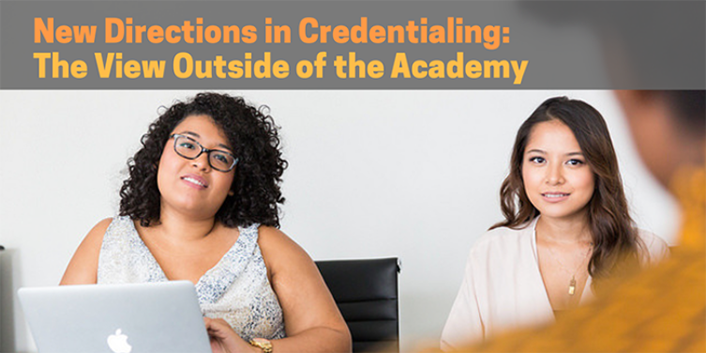
Institutions of higher education are starting to experiment with new forms of credentialing. The more ambitious are looking at developments in competency-based learning (CBE) and building programs in that model, which recognize learning achievements in new ways, from extended digital transcripts (the retrospective view) to digital badges (a prospective view).
Interest in this is becoming clearer as the signaling value of student’s experience in higher education is collapsing to a single variable: the brand of the institution. It’s a rich irony that in the era of exponentially increasing amounts of data, that which appears to be most salient to the performance of companies depending on new hires is contained in logo of their school.
How Employers Might View Credentials
Are employers really attending to the granularity that accompanies deployments of badging technologies? There is a significantly greater opportunity to understand what a student has demonstrated to earn a badge. Rubrics can help convey more openly what the instructor looked for to distinguish different categories of quality in the student’s work. And most useful of all perhaps is the potential to ‘see for yourself’ — through the evidence tag that can point to samples of the student’s work on which the judgment of quality has been made. Is it worth the employer’s effort to look this deeply?
What’s the motivation for companies to pay more attention to their hiring process? While some complain that the what universities offer by way of transcripts is far too crude a measure of performance, it does take effort to examine what these new signaling systems convey. One of the more progressive large companies by anyone’s measure today is Google. Their human resource department is called People Operations, and shares its research on effective management and publishes what it’s learning to the world on re:Work. In a section on hiring, they note:
“Companies continue to spend substantially more on training than on hiring. ASTD’s 2012 State of the Industry Report found that American companies spent $156,200,000,000 on learning programs in 2011.”
Conveying ‘Powerful Knowledge’
Getting a peek at what students claim to know and are relevant to a particular business or industry’s needs appears to be a terrific idea. It is ‘powerful knowledge’, the term Michael F. D. Young used to describe knowledge which “provides reliable and in a broad sense 'testable' explanations of ways of thinking; it is the basis for suggesting realistic alternatives; it enables those who acquire it to see beyond their everyday experience; it is conceptual as well as based on evidence and experience; it is always open to challenge…”1
That’s what we want badges in higher education to convey. But their association with the CBE learning movement leads some to condemn them to a simplistic, additive view of knowledge, that omits complexity and understanding the relationship among the elements learned. It is ‘cognitively restricting’.2
What’s an employer to do?
The current system of signaling learning through transcripts co-evolved with the needs of business to place graduates into jobs over many decades. Our academy is conservative and slow-changing. Some argue that is a virtue of even greater value in this time of rapid external cultural changes to avoid chasing ephemeral memes. It does challenge innovations that look like big leaps to a purportedly better state. The likely path to success in badges, as is true in many other cultural change practices, is to make the change appear as an incremental step, with the underlying technology capable of supporting much more.
The Value of Badges in Industry
Badges are likely to be better received and perceived as valuable by employers where they 1) have consistency, 2) represent consensus in their rubrics among faculty and industry representatives, and 3) are not overwhelming in number. A student who graduates with 1000 badges hasn’t done the institution or prospective employers any favors. Being deluged by plenty doesn’t make the job of businesses seeking the right employee for limited positions easier.
Credentials have value in the eyes of some by virtue of their scarcity. But we have an enormous contradiction to address. Governments and institutions of higher ed seek to increase the number of people with college degrees, to make them more plentiful. Lifetime earnings, satisfaction on the job, and relative employment prospects are positively correlated to a baccalaureate. What we need are credentials that are more explicit, open to scrutiny, contextually independent of the narrow focus of a course, and integrative.
They need to present examples of what the learner can do rather than just a number. We have plenty of examples of that, and it’s not sufficient.
Notes
- Young, M.F.D. 2010. Keynote introductory lecture to a meeting of the Goethe Project. University of Tübingen, 29 January, 4. Cited in Beck, J. 2013. Powerful knowledge, esoteric knowledge, curriculum knowledge. Cambridge Journal of Education. 43, 179
- Ibid.
Phillip D. Long, PhD, serves as Chief Innovation Officer and Associate VP for Learning Sciences at the University of Texas at Austin. Read his first post in this series: The Future of Digital Credentials: Portability, Depth, Focus. (Pick Two).
